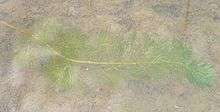Cabomba caroliniana
| Cabomba caroliniana | |
|---|---|
 | |
| Scientific classification | |
| Kingdom: | Plantae |
| (unranked): | Angiosperms |
| Order: | Nymphaeales |
| Family: | Cabombaceae |
| Genus: | Cabomba |
| Species: | C. caroliniana |
| Binomial name | |
| Cabomba caroliniana Gray | |
Cabomba caroliniana is an aquatic perennial herbaceous plant native to North and South America. It is a weed of national significance in Australia and on the list of invasive alien species of union concern in the EU.[1][2]
Common names
C. caroliniana is commonly called Carolina fanwort,[3] Carolina water shield,[4] green cabomba, fanwort, fish grass, and Washington grass.
Distribution
It is native to southeastern South America (southern Brazil, Paraguay, Uruguay, and northeastern Argentina),[5] and the East and West Coasts of the United States.[3] It is eaten as a vegetable in some areas.
Ecological aspects
This species grows rooted in the mud of stagnant to slow-flowing water, including streams, smaller rivers, lakes, ponds, sloughs, and ditches. In some states in the United States, it is now regarded as a weed. Fanwort stems become brittle in late summer, which causes the plant to break apart, facilitating its distribution and invasion of new water bodies. It produces by seed, but vegetative reproduction seems to be its main vehicle for spreading to new waters. Growth of 50 mm (2.0 in) a day has been reported in Lake Macdonald in Queensland, Australia.[6]
Large numbers of plants are sent from Florida to the rest of the U.S. for commercial use. Fanwort is also grown commercially in Asia for export to Europe and other parts of the world. Small-scale, local cultivation occurs in some areas, and aquarists are probably responsible for some introductions.
Description
Fanwort is a submerged, sometimes floating, but often rooted, freshwater perennial plant with short, fragile rhizomes. The erect shoots are upturned extensions of the horizontal rhizomes. The shoots are grass-green to olive-green or sometimes reddish brown. The leaves are of two types: submerged and floating. The submerged leaves are finely divided and arranged in pairs on the stem. The floating leaves, when present, are linear and inconspicuous, with an alternate arrangement. They are less than 1⁄2 in (13 mm) long and narrow (less than 1⁄4 in or 6.4 mm). The leaf blade attaches to the centre, where a slight constriction is seen. The flowers are white and small (less than 1⁄2 in (13 mm) in diameter), and are on stalks which arise from the tips of the stems.
References
- ↑ http://www.weeds.org.au/natsig.htm
- ↑ "Archived copy" (PDF). Archived from the original (PDF) on 2016-07-13. Retrieved 2016-07-14.
- 1 2 "Cabomba caroliniana". Natural Resources Conservation Service PLANTS Database. USDA. Retrieved 10 January 2016.
- ↑ "BSBI List 2007". Botanical Society of Britain and Ireland. Archived from the original (xls) on 2015-02-25. Retrieved 2014-10-17.
- ↑ Department of Ecology, Washington State: Cabomba caroliniana. Non-Native Invasive Freshwater Plants. Retrieved 16 August 2016
- ↑ Global Invasive Species Database
- Ørgaard, M. (1991). The genus Cabomba (Cabombaceae) - a taxonomic study. Nordic Journal of Botany 11: 179-203
- Gleason, H.A. and A. Cronquist. 1991. Manual of Vascular Plants of Northeastern United States and Adjacent Canada. The New York Botanical Garden, Bronx, New York.
- Hotchkiss, N. 1972. Common Marsh, Underwater and Floating-leaved Plants of the United States and Canada. Dover Publications, Inc., New York.
- Radford, A.E., H.E. Ahles, and C.R. Bell. 1968. Vascular Flora of the Carolinas. The University of North Carolina Press, Chapel Hill.
- Riemer, D.N. and R.D. Ilnicki. 1968. Overwintering of Cabomba in New Jersey. Weed Science 16:101-102.
External links
- Tropica
- Center for Aquatic and Invasive Plants
- Fanwort invasion in Washington waters
- Age of Aquariums
- Missouri plants